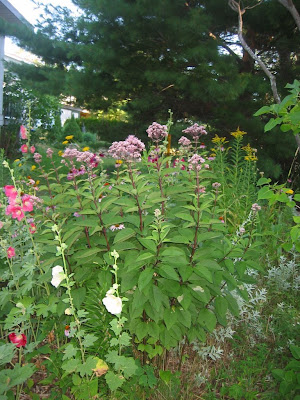 |
| JOE PYE WEED IN THE GARDEN; A HEALING PLANT... |
 |
| ...WITH BEAUTIFUL COMPOSITE FLOWERS AND SPOTTED LEAVES |
Joe Pye weed, Eupatorium maculatum, in the Sunflower Family, has just started blooming, right on time according to my records. It is named after an American Indian healer (common name), and the genus is named after the Greek King Eupator, who supposedly was the first to recognize the medicinal properties of the genus. The species name maculatum (Latin for spotted) refers to the spotted leaves, which grow in whirls of four on the strong, upright stems.
Joe Pye weed is a common North American plant native to damp fields and roadsides,
and is often seen in the garden, where its use probably derived from
medicinal herb gardens; it has also become a popular rain garden plant.
Its common name in herbal use is gravel root,
which alludes to its usefulness in treating diseases of the kidneys and
urinary tract (stones, or gravel), arthritis and gout. Both Joan and I often depend on
this plant in the treatment of our respective ailments but you will still have
to do your own research, I am afraid.
Another common native plant in
the genus is Eupatorium perfoliatum, boneset, much used in the past for
treating virulent, high fevers, and rumored to be useful in setting broken bones; the latter belief a holdover from the Doctrine of Signatures of the Middle ages, which attributed the medicinal values of plants according to their physical appearance, in this instance the rather unusual clasping of the leaves around the stem (perfoliate) which was taken to mean it was useful in mending broken bones. Needless to say, the Doctrine wasn't very scientific and only worked coincidentally. The white-flowered boneset was nonetheless a useful medicinal plant.
 |
| BONESET (Google photo) |











No comments:
Post a Comment